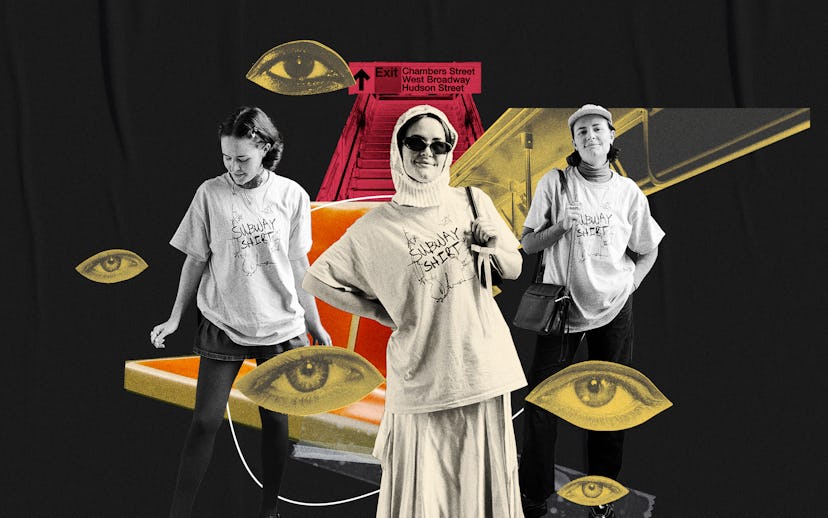
Fashion
The Rise Of The "Subway Shirt"
Conversations around “subway shirts” and “transit sweats” reached a peak this summer. But why is the focus still on what women are wearing?
In September, New York-based actor Kelley Heyer was heading to a New York Fashion Week runway show in a new top by ABL Studio. After putting their outfit together, Heyer added an oversized t-shirt on top before getting on the subway; it’s what Heyer and others online are calling a “subway shirt.”
“I had this whole really cute look, but, I, like many other women and femme people in New York, am uncomfortable dressing a certain way on the subway,” Heyer says. “Men will take the way I dress as an invitation to talk to me or even assault me.”
The idea of wearing a “subway shirt,” or any type of covering on the train, is an attempt to avoid sexual harassment on public transit. Heyer posted a video of her taking off her subway shirt once she reached her destination, and they had hundreds of comments relating to their experience (alongside misogynistic comments from men). After seeing the response, Heyer decided to create her own shirt with “subway shirt” written on the front, with the help of their friend Riley Scott. They have since sold one thousand “subway shirts” in under three weeks and raised over $12,000 for Planned Parenthood and The Yellowhammer Fund — as Heyer knew she didn’t want to profit off of the shirts. “Fashion is about joy and personal expression,” she says. “But sometimes it’s also a form of armor.”
While Heyer’s product may be one of the first designs to be specifically marketed as a “subway shirt,” the conversation around wearing one on the subway has been ongoing throughout the summer weather. In April, fashion creator Grace (@ideal.grace) posted a video on TikTok serving as a subway shirt reminder. "It's 85 degrees in NYC so ladies don't forget to bring your subway shirt,” she wrote. Others called this summer “modesty shirt season” or shared their “transit sweats,” worn over a miniskirt. One creator is even working on a “subway scrunchie,” which doubles as a hair accessory and fold-out t-shirt.
The “subway shirt” conversation seems to be an amalgamation of increasing rates of violent crime on the New York subway since 2019 and of the online trend cycle giving new buzzy names to conversations that women have been having in person for decades. “I think this is something that has always been happening, but because social media is so widespread, we are now seeing things that were invisible before,” says Heyer. “I think women are using social media as a way to talk about these things that we do every day, and talking about subway shirts is a way of saying, ‘Hey, I've always done this.’”
Harassment is undeniably an issue on public transit, with a 2018 report by the NYU Rudin Center for Transportation finding that female-presenting individuals reported “day-to-day experiences of harassment, catcalling, and general discomfort” when using public transportation. But while the “subway shirt” conversation may bring feelings of unity and community online to those facing harassment, Susan B. Kaiser, Professor Emerita at the University of California, worries that the very labeling of the garment “may reinforce the notion that how people dress is the root cause of unwanted attention or dangerous behavior on the part of others.”
Throughout history, directing the focus of sexual assault onto what the woman was wearing at the time, has been used as a diversion tactic for true accountability. By blaming the victim for wearing certain clothes — which we’ve seen across courtrooms and in popular culture — the blame becomes shifted onto them rather than the perpetrator of the violence. Erinn Robinson, Director of Media Relations at RAINN, says that the fight back against the “What were you wearing?” victim-blaming trope isn’t necessarily new, but the ways in which people try to protect themself from sexual harassment (and the escalation into sexual violence) continue to evolve.
It seems this year’s “subway shirt” conversation is simply the latest iteration of women attempting to find solutions within a society that continuously disregards their safety. It’s also another example of the onus being put on women to “avoid” male violence, instead of men actively working on the issue. “A woman taking measures to feel safer from perpetrators of sexual harassment or sexual violence doesn’t mean she assumes responsibility for the perpetrator’s actions,” says Robinson. “Sexual harassment is always and only ever the fault of a perpetrator. Full stop.”
While the rise of the “subway shirt” could easily blend into the revolving door of other internet trends this year — framed under a light-hearted tone and a cute name — the conversation itself is a stark reminder that we still have a long way to go until women and queer people feel safe in public spaces. “If anything, this proves we have more work to do in shifting the victim-blaming mentality of our culture, and more to do to educate people about sexual harassment, including educating those who might perpetrate it,” says Robinson, noting that the goal, of course, should be a world without “subway shirts.”
“We need to educate the public on why they should not be necessary in the first place.” Until then, you may be seeing more women riding on public transit with the words “subway shirt” written across their chest.
This article was originally published on